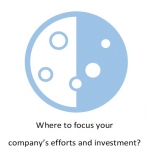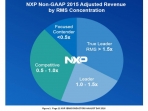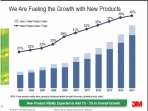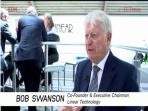Marketing Generics Blog

Focus, Focus, Focus
Thursday, June 04, 2020
I was reading with interest the EETimes’ interview with NXP’s new CEO Kurt Sievers. Obviously not a great time to be taking over any company as the new CEO! But a couple of things he says, particularly about focus and market share caught my eye.
Why Relative Market Share (RMS) is a better metric than Market Share
Sunday, August 28, 2016
Market share has become the Holy Grail for many businesses as they place heavy emphasis on what market share (MS) they have or plan to have. Many marketers are judged and evaluated on the MS they achieve for a product, segment or application, in FMCG markets, marketers typically being judged on MS performance to two percentage points, so they could be critically evaluated on whether their MS is 15,56% or 15,65%, for example. However, more companies are looking at using Relative Market Share (RMS) as their metric.
Can business learn from the Rugby World Cup?
Wednesday, October 21, 2015
As an avid, but now somewhat embarrassed supporter of the English rugby team, I am enjoying the spectacle, the sublime rugby. The southern hemisphere seems to have wiped the floor with the northern hemisphere, and France and England in particular have looked slow, plodding and bereft of ideas. Now there is ardent debate about ‘what went wrong’ and particularly ‘how does New Zealand actually do what they do’?
Some consensus seems to be emerging: it’s about skill and skills, not brawn, not size. Not set pieces, but flair and innovation (the breakout). Everyone in the team joining in the attack (eg., prop forwards scoring tries). And finally, determination to succeed – a culture of ‘winning’ rather than just ‘playing’. The most telling comment I’ve read is this: “In New Zealand we teach skills first. Everyone must have really good basic, ball carrying and handling skills. After that, and only then, can they move to specialist positions and tasks”
Are there lessons here for business?
Corporate Vision and Mission Statements - the good, the boring, and the downright scary
Tuesday, October 06, 2015
Any corporation worth its salt today is almost obliged to have a Company Vision and Mission statement, like any self respecting kid in school must be seen with the latest iPhone. The vision and mission statements shows that the company is, well, er, visionary, and long-termist, as opposed to, er, its financial results and normal knee jerk reactions which are usually extremely short-termist. What different types of Vision and Mission statements can there be?
Vitality Indeces and Innovation
Thursday, July 09, 2015
China recently decided to offer subsidies for Chinese companies who apply for patents abroad in an effort to ensure that their Chinese technology belongs to Chinese companies and is properly protected. But the success rate of patents applied for to patent granted is only around 20%, and the success rate comparing patents applied for and those which are commercially viable is around 0.2%, so statistically speaking, any patent being filed only has a 0.04% chance of achieving commercial success!
Patents are visible register of the company’s innovation, but companies need to look at other measures like the Vitality Index, which measures the % of revenues coming from new products over N recent years. Innovation has to be linked to and derived from a deep understanding of the market, and this means that numerous actors are involved in creating Vitality. Typically this should start in Marketing, who have the responsibility for identifying needs and translating them into demands, thus driving the R&D to a clear commercial output. Similarly, great designs are worth nothing if they arrive on the market too late, too little or over-specified, or if Marketing and Sales are unable to organise and mobilise the ramp to achieve superior TTV. So whist the Vitality Index is often said to measure innovation and ability to develop products, it's really all about the ability of a company to commercialise its ideas and intellectual capital, and it needs all the parts of the process to pull together. 3M are generally recognised to be at the lead of this movement, and this is a pretty interesting slide here from the 3M presentation at William Blair31st Annual Stock conference in 2011. Otherwise my Application Note explains all about Vitality Indexes – whey they are important, how they are calculated and what your Vitality Index should be
Learnings from a leader
Wednesday, March 11, 2015
I sat in on a fascinating talk the other day given by a VP who heads up the China business for a major western industrial product business. Whilst on the one hand it was a magisterial tour de force of the sheer size and scale and growth of the China market he is facing, it was also a masterclass of a leader at the top of his game. It seemed useful to try and capture and then deconstruct and decipher how and why he gave such a strong leader’s talk. What leadership characteristics did he show?
Inside Linear Tech: how do they consistently get such good financial results?
Sunday, November 30, 2014
Whilst Linear Technology is hardly and well-known household name, most people in the semiconductor business will know, respect and maybe (if you’re a competitor) fear this capable and highly successful analog semiconductor supplier. Whilst not the biggest company on the semiconductor planet at almost $1.4bn revenues (2014), it is one of the most profitable and consistently profitable, in a tough, competitive market. Swimming with whales and sharks in a $330bn market, Linear is a relative minnow but has managed to carve out a niche for itself in the areas of high-performance analog - “’High performance may be characterized by higher precision, higher efficiency, lower noise, lower power, higher linearity, higher speed, higher voltage, more subsystem integration on a single chip and many other special features”. (Source: Linear Tech 10K 2014 page 5).
“Air France pilots threaten to extend strike indefinitely”
Tuesday, October 07, 2014
(But has just ended after 14 days)
I just wanted to say a personal note of thanks to all the Air France pilots who potentially left me stranded without a flight back from China. Silly me, I had forgotten to check the National Strike Calendar before I booked the flight with you. But thinking about it, it wouldn’t have been much good, because apparently you are threatening your employer not just with a number of strikes at certain key times in the year, but to go on strike “indefinitely”! French intransigence knows no bounds.
Ridiculously high costs (not totally unlinked to the pilots’ pay and benefits) has driven Air France (AF) into a corner, attacked by the high end luxury carriers on long-haul, and Ryanair and Easy Jet et al on the short haul – this made AF management take the wholly unreasonable step of saying that they would have to respond to the low cost (LC) carriers with like for like, launching their own new LC sub-brand – Transavia- for which they would recruit pilots on completely new and non-AF contracts. The thought of that new business actually responding to customer needs and doing well has driven myopic AF pilots into Luddite, crude and blunt responses, going on strike and blaming AF management. The pilots’ unions SNPL and the smaller SPAF have been claiming that "Air France management has total responsibility for the conflict with its pilots".







